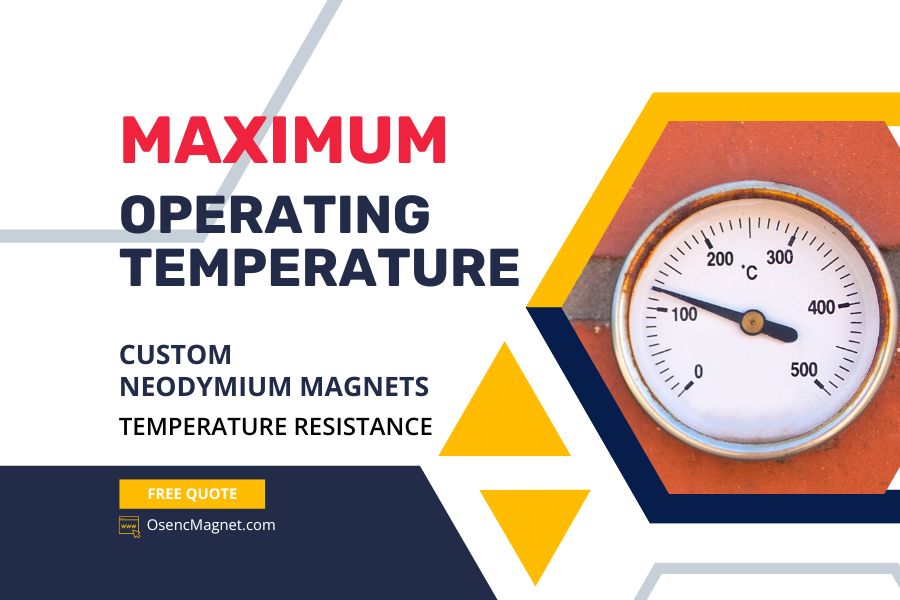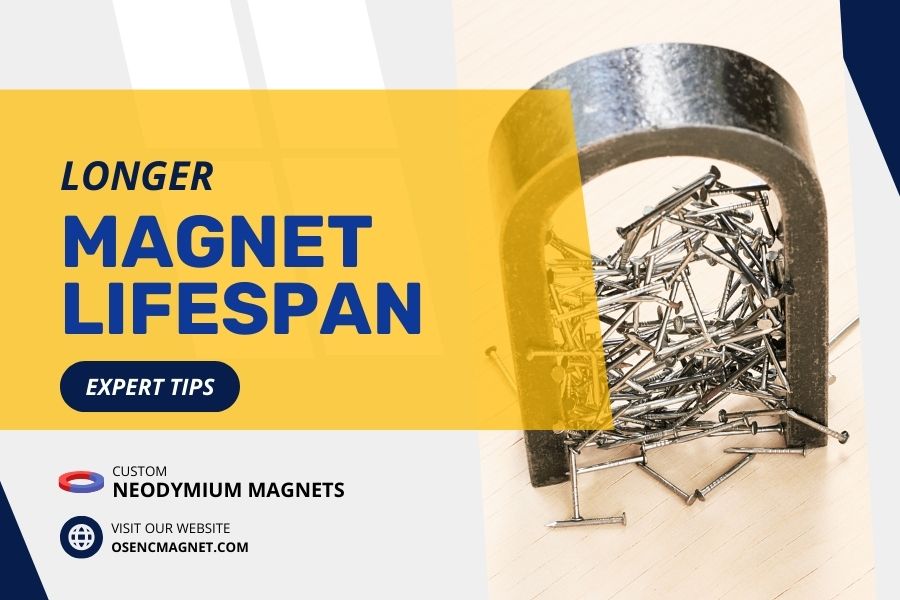Temperature impacts neodymium magnet performance and lifespan.
This quick intro covers max operating temperature.
Learn how heat affects magnetic properties.
Discover ideal temperature ranges by magnet grades.
If you use magnets, this brief overview is key.
Let’s quickly cover safe temps for the strongest magnets.
Introduction
Definition
The Maximum Operating Temperature of a magnet refers to the highest temperature at which it can maintain its magnetic properties without experiencing irreversible losses.
- This parameter is crucial in ensuring the efficiency and longevity of your magnet in its intended application.
When magnets are heated above their maximum operating temperature, they can experience irreversible loss of magnetic strength.
Here’s a summary of what happens:
Reversible Loss (up to max operating temp)
Magnets temporarily lose some strength while hot.
- But fully regain it when cooled back down to room temperature.
- For neodymium, this reversible loss is about 0.11% per °C rise in temperature.
Irreversible Loss (above max operating temp)
Heating above the maximum operating temperature causes permanent, irreversible loss of some magnetic strength.
- The magnet will be weaker even after cooling back down. The loss is not recovered.
Repeated heating to the same temperature above max operating temp does not cause additional irreversible loss.
The magnet could theoretically be re-magnetized to restore most of the lost strength.
- But this is not practical or cost-effective.
Permanent/Complete Loss (Curie temperature)
Heating to the Curie temperature causes complete, permanent demagnetization.
- The magnet permanently loses its magnetic properties and cannot be re-magnetized.
Temperature Grades
The maximum operating temperature varies depending on the type of magnet material.
Neodymium (NdFeB) Magnets
Standard grade neodymium magnets have a maximum operating temperature of 80°C (176°F).
Higher temperature grades are available with the following max operating temps:
- Grade M: 100°C (212°F)
- Grade H: 120°C (248°F)
- Grade SH: 150°C (302°F)
- Grade UH: 180°C (356°F)
- Grade EH: 200°C (392°F)
- Grade AH: 230°C (446°F)
Neodymium magnets start to lose magnetism irreversibly above their max operating temp, even though their Curie temperature is 310-400°C.
Samarium Cobalt (SmCo) Magnets
SmCo magnets have max operating temperatures of 250-350°C depending on grade.
They have a Curie temperature of 700-800°C.
Alnico (AlNiCo) Magnets
Alnico magnets have the highest max operating temperature at 525-550°C.
Their Curie temperature is around 800°C.
Ferrite (Ceramic) Magnets
Ferrite magnets have a maximum operating temperature of 250°C.
Their Curie temperature is approximately 450°C.
In summary,
- For high temperature applications above 150°C, SmCo and Alnico magnets are the best choices.
Neodymium magnets, while the strongest type, have lower maximum operating temperatures unless special high-temp grades are used.
The maximum operating temperature should not be confused with the Curie temperature – irreversible losses occur well below the Curie point for most magnet types.
Heat Insulating Materials
Here are some materials that can be used to insulate neodymium magnets from heat.
And help maintain their magnetic properties at elevated temperatures.
Mica
Mica is a naturally occurring mineral that has excellent thermal insulation properties.
It can withstand temperatures up to 1000°C and provides good electrical insulation as well.
Ceramic Coatings
Ceramic coatings like aluminum oxide or zirconium oxide provide thermal barrier protection for neodymium magnets.
These coatings have low thermal conductivity and can operate at high temperatures.
Epoxy Resins
High temperature epoxy resins are polymer coatings that provide thermal insulation for magnets.
Special formulations are available that can withstand temperatures of 200-300°C.
Silicone
Silicone rubber coatings have good thermal stability and can insulate magnets up to about 300°C.
Silicone also provides impact resistance and protects against corrosion.
Polyimide
Polyimide is a high-performance polymer that maintains its properties at elevated temperatures.
Polyimide coatings and tapes can provide reliable thermal insulation for neodymium magnets in demanding applications.
Fiberglass
Fiberglass cloth and sleeves woven from glass fibers are excellent insulators.
Fiberglass insulation can protect magnets from heat up to about 500°C.
The choice of insulation material depends on the specific temperature requirements, environmental conditions, and mechanical demands of the application.
Factors like the maximum operating temperature, thermal cycling, impact resistance.
And chemical exposure should be considered when selecting an appropriate thermal insulation solution for neodymium magnets.
Buying Tips
Customizing magnets
In some cases, standard magnet materials and grades may not perfectly align with your application’s temperature requirements.
Working with a magnet manufacturer, you can customize magnets by altering their composition, size, or shape.
They will better suit your application’s specific temperature demands.
Protective measures
If your application involves extreme temperatures or harsh environmental conditions, consider additional protective measures such as coatings or enclosures.
These can help protect your magnets from corrosion, wear, and other damaging factors, ultimately extending their lifespan and maintaining performance.
Conclusion
This intro covered max operating temperatures for different magnetic materials.
Let me know if you need magnets for high temp applications.
Email me your project details.
I can help you with the right magnet material to withstand your temperature needs.



